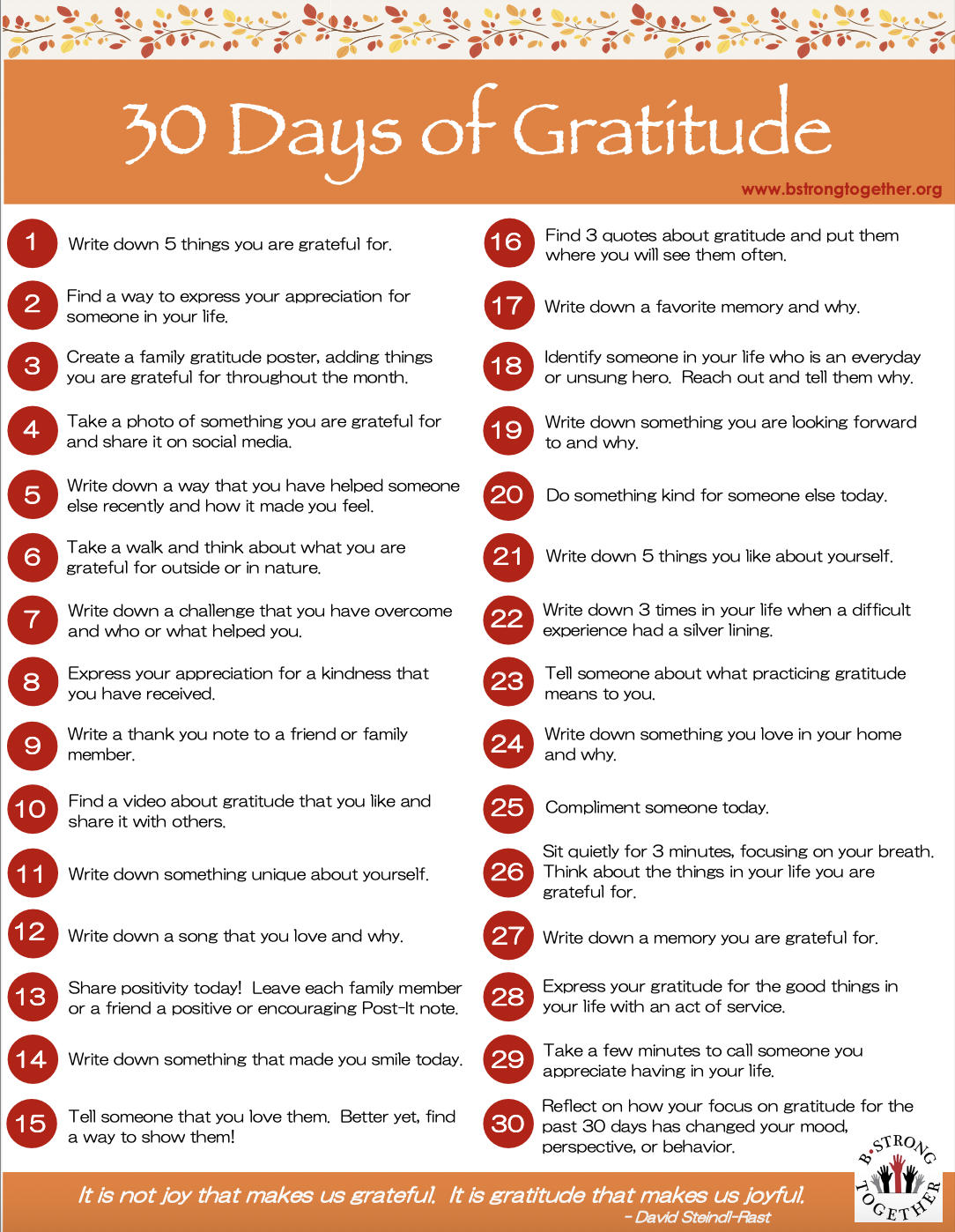
Growing Gratitude in Your Family
by Kyle Kick
BStrong Together Executive Director
As the seasons change and with the coming of the Thanksgiving holiday, November is the perfect time to focus on the powerful practice of gratitude.
Simply put, gratitude is a feeling of being thankful and appreciative, affirming the goodness in our lives and acknowledging the role that others play in that goodness.
In a Harvard University School of Medicine article, gratitude is identified as “strongly and consistently associated with greater happiness. Gratitude helps people feel more positive emotions, relish good experiences, improve their health, deal with adversity, and build strong relationships.”
Research shows that gratitude has wide-ranging benefits for our physical and mental health, happiness, and success. Gratitude builds connections and deeper relationships with others, increases self-esteem, builds resiliency, and reduces depression. It increases a sense of relaxation, sleep quality, energy levels, and vitality while reducing stress, pain and blood pressure. Gratitude encourages pro-social behavior leading to greater kindness toward others, and research shows that grateful people are both more likely to reach out to others in times of need as well as help others and provide support to those who are struggling.
At work, gratitude increases productivity and decision-making, creates a more pleasant work environment, deepens connections, and helps with reaching career goals.
And it makes us happier, too! Researcher and author Brene Brown explains the powerful connection between gratitude and joy in this short video.
Gratitude doesn’t always come naturally, but the good news is that adopting gratitude practices trains the brain to focus on positive experiences, interactions, and emotions. Gratitude and its benefits to our health and well-being grow as we practice it.
Here are some ways to encourage gratitude in your life and with your family:
- Create a Three Good Things gratitude journal. In a 2005 study by founder of the University of Pennsylvania’s Positive Psychology Center, Martin Seligman found that writing down three good things each day for a single week had long-term effects, increasing happiness for six months! Learn more about the Three Good Things practice here.
- Read books as a family that teach and model gratitude. Use the stories and lessons learned as an opportunity to talk about gratitude in your life. Here is a great list of books from Growing Book by Book that teach about gratitude and appreciation.
- Print out this list of Table Topic questions about gratitude and thankfulness to discuss at your dinner table from the Family Dinner Book Club. Pick a question each night to talk about what you are grateful for.
- Create a family gratitude jar or book to write down and save moments of gratitude.
- Create a gratitude tree. A fun Thanksgiving idea – make an interactive centerpiece at your Thanksgiving table as each guest adds leaves of thanks to the family gratitude tree.
- Write letters of gratitude to those who have positively impacted your life.
- Practice savoring positive life experiences and celebrate the present. Mindful practices go hand-in-hand with the practice of savoring – taking a pause to appreciate a moment or a feeling, appreciating the small pleasures in your everyday life.
- Go on a gratitude walk in nature with your family, noticing things are you grateful for with your five sense.
- Share moments of gratitude at dinner each night or as part of your bedtime routine.
- Model gratitude with your children, showing them how to identify and focus on the positive experiences, big and small, in their life.
- Become gratitude explorers on the lookout for opportunities to feel grateful.
- Check out these other great ideas for incorporating gratitude practices in your family from Kelly Miller at the Positive Psychology blog.
Be sure to download and print our 30 Days of Gratitude handout with daily activities to get you started.

Wishing you a wonderful month of slowing down to savor the goodness in your life and showing your gratitude to others.
